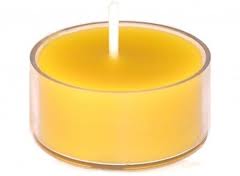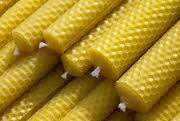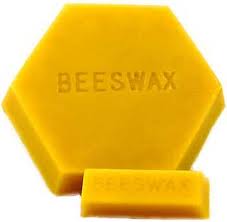
Beeswax vs Paraffin, which is better and safer? Both are natural but both are not safe….
Beeswax
Beeswax is a natural wax. it is produced buy the female worker bees in honey beehives.
This wax is used to build the honeycomb cells and it is build with three purposes; raising their young, storing honey, and pollen. It takes eight times the consumption of honey to create this wax, and it is estimated the bees will fly over 150,000 miles to create just one pound of bees wax. Wow!
The type of flower that the bees gather nectar from will determine the color of the wax, it will vary from white to brown, but is most often a shade of yellow. The color of the beeswax is white at first, but then darkens with age.
 The color of the wax has no significance as to the quality other than its aesthetic apppeal. Beeswax used to be bleached using ozonisation, sulfuric acid, or hydrogen peroxide which not only bleached the wax but resulted in the addition of chemicals into the wax. This process has now been stopped by reputable candle manufacturers and other supplier of this natural wax.
The color of the wax has no significance as to the quality other than its aesthetic apppeal. Beeswax used to be bleached using ozonisation, sulfuric acid, or hydrogen peroxide which not only bleached the wax but resulted in the addition of chemicals into the wax. This process has now been stopped by reputable candle manufacturers and other supplier of this natural wax.
About 60% of beeswax is used in candle making, cosmetics and pharmaceuticals. It is also used in polishing materials for shoes, furniture, models, pool table filler, and as a protective coating for aging cheese. Beeswax can be softened with vegetable oil to make it softer and more workable.
Beeswax vs Paraffin
 In beeswax vs paraffin and candle making, beeswax is the best. The most important aspect of beeswax, besides being natural is they burn brighter, longer, and cleaner than any other candle! The flame virtually emits the same light spectrum as the sun and in the process of burning, negative ions (which is a positive thing) are released to clean the air and invigorate the body. The negative ions is what the air smells like after a storm.
In beeswax vs paraffin and candle making, beeswax is the best. The most important aspect of beeswax, besides being natural is they burn brighter, longer, and cleaner than any other candle! The flame virtually emits the same light spectrum as the sun and in the process of burning, negative ions (which is a positive thing) are released to clean the air and invigorate the body. The negative ions is what the air smells like after a storm.
This 100% natural fuel created by bees is naturally scented by the honey and nectar of the flowers packed into the honeycombs and gives off a subtle fragrance as it burns. If the beeswax has a medicinal smell, chances are that it has been chemically altered or bleached. Always check for 100% beeswax, for the legalities on labeling these candles states that a mere 55% content can be called beeswax, and for soy candles, a minumum amount of 20% soy wax can allow for those type of candles to be called soy. So beware and once again watch the labelling.
Beeswax vs Pariffin
Beeswax is a 100% natural fuel created by bees;
- burns cleaner
- burns longer than others and does not drip
- emits a bright light that has the same light spectrum as the sun
- emits negative ions that actually clean the air and invigorate the body
- are naturally scented by the honey and nectar of the flowers packed into the honeycomb within the beehive
- come from a renewable source
Paraffin candles come from a nonrenewable resource: petroleum, A.K.A. crude oil;
- give
 off many of the same toxic fumes as are found in auto exhaust
off many of the same toxic fumes as are found in auto exhaust - are relatively short burning and drip excessively
- is a toxic byproduct of the oil industry
- produce a disorganized light spectrum very similar to old fashioned incandescent bulbs
- produce toxic petrol-soot that eventually stains all interior surfaces
- typically contains artificial fragrances and colors which also produce toxins and stains when burned
In beeswax vs paraffin, it’s like natural vs synthetic!
Wikepedia has an article on paraffin here……
The wick is just as important as the type of wax, because when you burn a candle that has a chemically processed or metallically reinforced wick, it can release large amounts of soot into the air you breathe. This can be potentially harmful to your health.
So when making candles be sure to find 100% unbleached cotton wicks, this will help keep the air clean.
Beeswax vs Paraffin in Soapmaking
Beeswax vs paraffin in soapmaking too! You were probably wondering when I was going to get to that.
Paraffin would be a cheap and easy way to make bars harder and last longer, but wouldn’t that defeat the purpose of having a natural soap bar?
Beeswax is often used in soapmaking as well, put the wax in at the same time you put the oils in as the beeswax has a high melting point and might nut fully melt if you add it later on in the process. Usually this amazing wax is added to soap for the added hardness of the final bars.
The scent of honey is just an added bonus!
Don’t add more than 1.5% of wax to your total oils and fats. If you add to much wax you will end up with a sticky and gummy bar and that would not be good.
© 2016, Tes. All rights reserved.
Hi Teresa,
Extremely informative site.
I have never thought about making my own soap but I was very intrigued with your detailed step by step guide and photo’s.
You obviously have the process down to a fine art may I ask how much soap you make from one batch?
Keep up the Awesome Work!
Grant.
Thanks Grant. Yes I have been making soap for over 20 years, I can almost do it in my sleep lol. I like to do smaller batches so with my Olive oil soap I do batches of about 32 bars and for my Hemp and other specialty soaps I do them in batches of about 15 bars. Thanks for stopping by my website. Have a great day!
This is excellent I mentioned something about making our soap naturally. To my wife the other day. The soap we buy from the stores has so much harmful things in it. You will be better off doing it yourself. This is great and I will be sure to use your site. Well this post as a blueprint. When I go get the ingredients and create my own soap.
Thank you so much.
Your right James, some of those store bought soaps have so many chemicals in them. Be sure to check out this page for step by step instructions on making basic soap. I have added pictures to help you follow along.
How to Make Soap at Home -Step by Step instructions with pictures
This article is good, especially for those who love candles like me. And I always love beeswax as how natural it is. I love how you pointed out that it’s clean and even burns longer than others. What’s more, it doesn’t drip, so it’s really awesome. Thanks for sharing this! It’s helpful for me.
Thanks Jessica, I’m glad you liked the article and found it helpful.
Paraffins are found in so many consumer products that its disgusting. Unfortunately, big companies worry only about their pockets and never the health of it’s consumers, the same people making them super wealthy. But it’s good that we have alternatives like beeswax. Even though the major brand products don’t use it, we now know so we can make the choice to look for products with this natural alternative instead.
It’s always great to get comments and hear for other people. Thanks Wing for your comments, it really is a shame that the major companies don’t worry as much about the health of the people they supply as we do, but the more we can educate people about the alternatives the better.